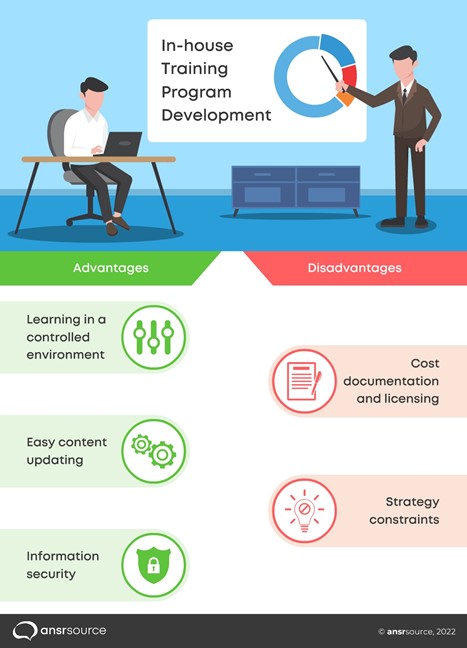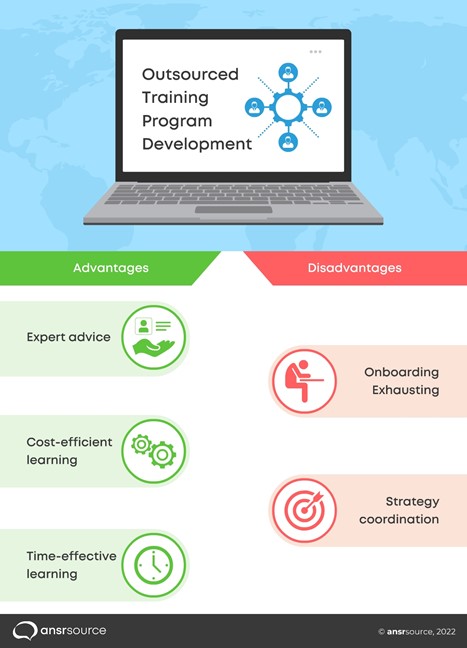Training programs are regarded as an essential component of employee development. They are a structured method for cultivating specific skills through knowledge sharing, teaching, coaching, and practice.
Employee training programs are popular in both start-ups and existing business models as they provide many benefits—continuous learning, upskilling, employee retention, and more. Many companies understand the intrinsic benefit of training and, as a result, a sizable percentage of their budget is devoted to training and development efforts.
Different ways of developing training programs
Training programs tailored to fit a company’s needs can have a positive influence on workforce productivity and efficiency. Broadly, there are two ways to design training programs for employees: designing training in-house or outsourcing. We’ll discuss below the advantages and disadvantages of each approach.
Designing training in-house:
Developing training programs in-house means that a company creates L&D programs using its own resources and internal staff. Most companies practicing in-house training models dedicate a department specifically to training and hire L&D professionals and subject matter experts to create and manage training programs. The department is solely responsible for designing and executing the pedagogy.

Advantages of in-house training program development
- Learning in a controlled environment: The development process is managed based on organizational guidelines and expectations, and results can be verified easily.
- Easy content updating: Learning content can be updated seamlessly based on changing industry trends and market behavior.
- Information security: In-house development allows a company to avoid disclosing sensitive information to a third party.
Disadvantages of in-house training program development
- Cost of documentation and licensing: In-house training is a costly affair for businesses. Hiring in-house L&D staff and procuring appropriate software, authoring tools, audio and video editing tools, and other resources, as well as paying the license fees that come with all of this software, adds up to a substantial financial investment.
- Strategy constraints: To establish and train an in-house L&D team requires strategy, effort, and time. Some businesses have such quick and agile operations they that do not have time to devote to in-house L&D activities.

Outsourcing: Outsourcing training is becoming a popular option for businesses as it provides the financial flexibility required in a fast-paced environment.
When a corporation chooses to utilize an external organization or a professional expert to manage the training needs of its employees, this is called outsourced training. Sometimes, a firm hires specialists to deliver a training program that already exists. This is also a branch of outsourcing training. Approximately 45% of U.S. businesses outsource their learning.
Advantages of outsourced training program development
- Expert advice: Outsourcing L&D activities allows access to specialists with extensive experience in training, instructional design, writing tools, and other areas. These experts are aware of current trends and can utilize them in training development.
- Cost-efficient learning: Outsourced training brings in subject matter experts (SMEs) on a project-by-project basis, with no long-term commitment to a development team. Outsourcing firms usually charge on an hourly basis to develop training materials.
- Time-effective learning: Outsourced L&D offers the advantage of faster turnaround times and quicker development than an in-house development team can typically provide.
Disadvantages of outsourced training program development
- Onboarding exhaustion: The primary drawback of outsourcing L&D is the time required to onboard a new partner and get them to work on deliverables that match the organization’s goal. It is a tiring process to select the best partner with all required competencies.
- Strategy coordination: Every organization has its own learning strategy, learning style and specific requirements for learning programs. It is often difficult to find a partner organization that can understand your unique approach and come up with solutions around it.
Why do firms outsource development of employee training?
More and more companies consider the pros and cons and make the choice to outsource the development of training programs. Let’s take a closer look into why a company might choose to outsource.
- Subject matter experts: Firms that create training programs often have subject matter experts on staff who design and write training programs to upskill or reskill employees. These learning experts study the market diligently and modify their training content based on evolving trends and new discoveries. It can be difficult for an individual company to maintain in-house subject matter expertise.
- Expanded resources: Sometimes the training requirements are simply too broad for a firm to tackle in-house. Assume you have a marketing team, an IT team, customer service reps, and sales specialists in your company, and each department requires a distinct type of training. Externally sourcing instructional design and subject matter expertise may be the only realistic choice to meet your diverse training needs.
- Professional approach: Perhaps a company is small and no one within the company possesses the professional and technological competencies necessary to create an effective and efficient training program. This alone might motivate a firm to outsource to a partner with greater depth of professional and technological expertise.
- Dedicated services: Employee training is critical, but creating, administering, and delivering training can divert attention from vital business operations and impose time limitations. As a result, many organizations outsource to ensure that the task is completed without creating any delays or disturbances to routine business activities.
Around 42% of the typical training budget is spent on outsourced services. This is a solid indicator that companies recognize the value of partnering with qualified e-learning experts who offer them the necessary experience and skills to provide customized training to their staff. It will be interesting to see, as the learning landscape continues to evolve and more training than ever before goes digital, whether companies will choose to outsource more or less to meet their training needs.
After working with L&D teams at some of the top organizations around the world for almost two decades, we have noticed that using custom content has enhanced learning exponentially. This is because the learning program is designed keeping the learner persona in mind, and achievement of organization specific learning objectives as the aim. Thus, irrespective of whether the training programs are designed in-house or outsourced, custom development of content may be the best way to achieve learning goals.



